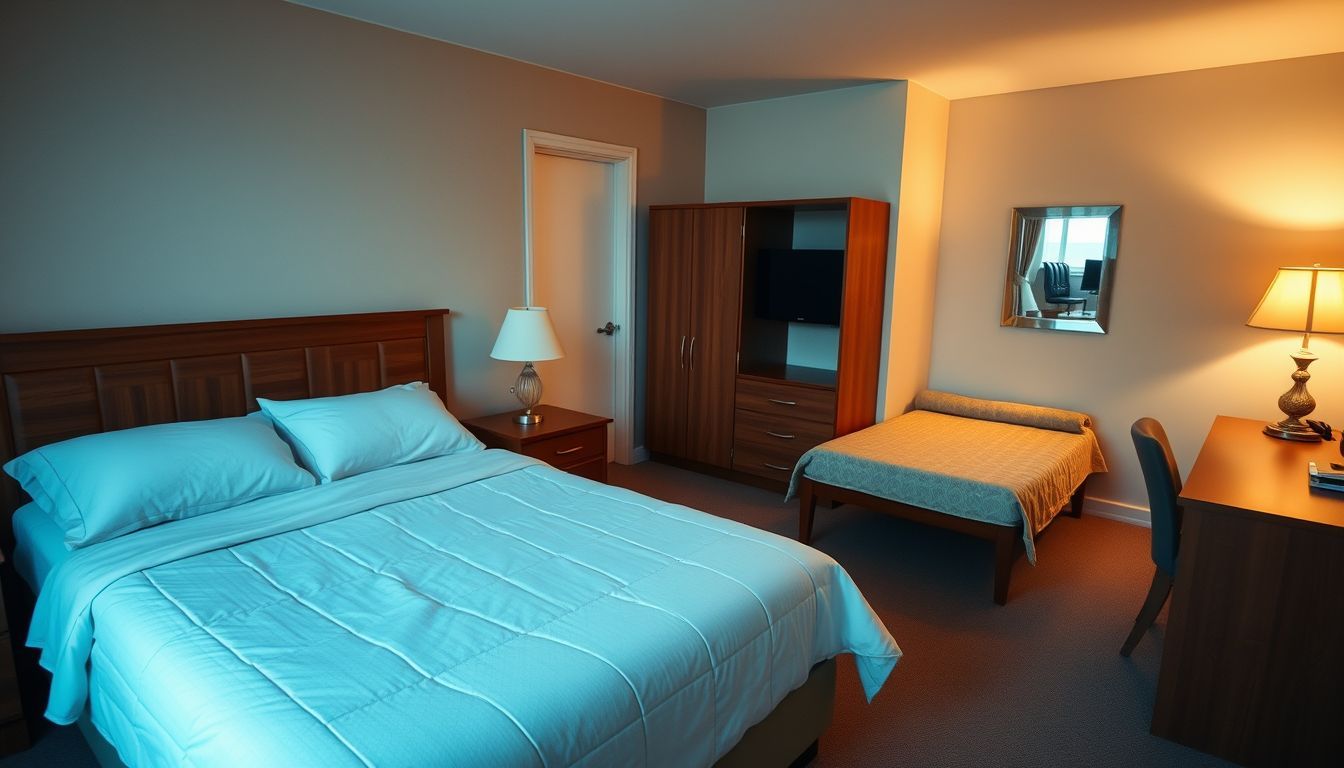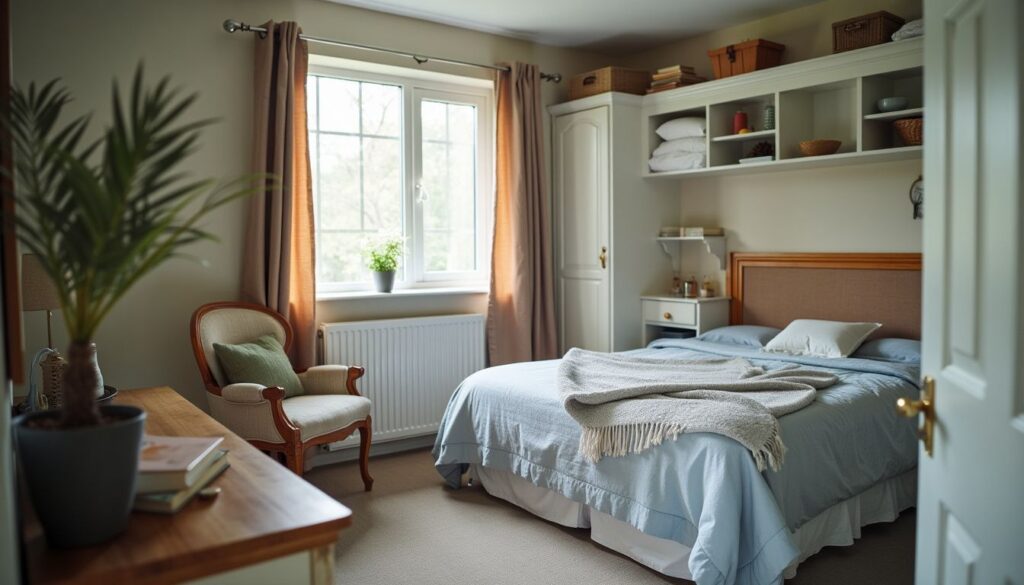Creating a bedroom that works well for caregivers is hard. Marcus Stow, a nurse, had to change his parents’ room a lot after they left the hospital. This article shows how to make these rooms better and safer.
Keep reading to learn how.
Key Takeaways
- Make space around the bed and keep paths clear for easy movement. Remove rugs or secure them to decrease falling.
- Use cool colors and durable furniture in the bedroom. Add tech like IoT sensors for safety.
- Choose adjustable beds and tables, and look online for special caregiver furniture. Check sizes, reviews, and delivery options before buying.
Designing for Accessibility

Making a bedroom easy for caregivers starts with smart design. Think about making more room around the bed and clear paths to move easily.
Optimize Resident Room spaces
Create easy paths around the bed and through the room. Clear spaces help caregivers move without trouble. Make sure there is enough room for lifts and mobile devices. These tools are vital for elder care.
Marcus made space in his mother’s room so caregiving was simpler.
Use smart design to keep important things close. This means beds, chairs, and lights can adjust as needed. Add storage for personal protective equipment and medications nearby. Good design cuts stress for everyone.
CMS suggests rooms just for one person. Privacy helps with mental well-being and dignity. Natural light, a good ventilation system, plus heating and air conditioning keep the room comfortable year-round.
Maximize open areas around bed and primary paths
Moving from optimizing room spaces, the next step involves maximizing open areas around the bed and main paths. This ensures smooth movement for both caregiver and resident.
- Keep at least 3 feet of space on all sides of the hospital bed. This allows easy access for caretakers.
- Place furniture like nightstands and chairs away from the bed’s direct path. It makes moving around simpler.
- Use wall-mounted lights to save floor space. This improves illumination without cluttering the area.
- Choose adjustable hospital beds that can be easily moved or resized as needed.
- Install grab bars near the bed and along primary paths to support safe movement.
- Ensure cords from lamps, phones, or medical devices are neatly bundled and off the floor to prevent trips.
- Use motion-activated lighting so caregivers can navigate easily at night without searching for switches.
- Secure rugs with non-slip mats or consider removing them entirely to reduce fall risk.
Each of these steps contributes to a safer, more accessible bedroom environment for both caregiver routines and resident comfort.
Enhancing Safety and Comfort
Making a bedroom safe and comfy is key. Pick soft, calm colors and strong furniture to help with this.
Choose calming colors
Cool blues, greens, and natural tones make a room peaceful. This choice is sure to calm the mind. Adding live plants and soft lights also helps. These colors and items create a restful space for both caregivers and those they look after.
Using personal items makes the bedroom feel more like home. Strong Wi-Fi supports telemedicine visits and keeps personal electronics connected. Personalizing with technology, like LED TVs, boosts engagement in self-care activities.
Select durable furnishings
After picking calming colors, the next step is to choose furnishings that last. Durable furniture offers both comfort and value over time. For example, chairs with pressure cushions support health and prevent sore spots.
Tables that adjust in height promote independence by allowing easy access for different tasks.
Storage options are key for keeping caregiver tools handy. Deep drawers near the bed make it easy to reach items quickly. These strong pieces of furniture can handle daily use without showing wear too soon.
This means less money spent on replacements and more focus on care.
Implementing Efficient Technology
Putting in smart tech helps caregivers a lot. Things like remote health trackers and programmed lights make tasks simpler.
Use more technology for monitoring and assistance
Use IoT sensors to keep an eye on the room. These gadgets can tell if someone falls or needs help. Smart home apps control lights, temperature, and more with a tap on a smartphone.
This tech saves time and cuts down on running around.
Add motion-activated lighting to make moving safe at night. Put in devices that stop stoves from catching fire to prevent accidents. Voice-activated phones let you call for help without touching the device.
All these tools increase safety and make caring easier.
Opt for innovative technology in furniture and fixtures
Moving from monitoring technology to furniture, caregivers can find great tools. Adjustable beds and tables let patients move easily. This means better comfort and more independence.
Durable furnishings last longer, saving money. Add modern LED TVs and strong Wi-Fi for fun and connection.
Contacting a design team helps get custom solutions. They use augmented reality to show new layouts before buying anything. This saves time and makes sure everything fits right the first time.
Caregivers can order these items online, making it simple to upgrade a bedroom quickly.
How to Order Online: Caregiver Bedroom Furniture
After exploring technology for furniture, let’s look at ordering caregiver bedroom furniture online. This process makes getting the right items simple and effective.
- Start by measuring your space. Know the size of the area where you plan to put new furniture.
- Visit websites that sell durable and comfortable furnishings. Look for stores with good reviews.
- Search for adjustable beds and tables to ensure they fit well in the room and meet your needs.
- Check each item’s details carefully. Look at the materials, dimensions, and features like height adjustment.
- Read customer reviews on products you’re interested in. They offer insights on quality and usability.
- Consider products designed for long-term care or nursing homes as they promise durability and safety.
- Use filters on websites to narrow down options—select by size, color, or type.
- Pay attention to delivery options. Free delivery can save costs.
- Look at return policies and warranties before buying to make sure you can return items if needed.
- Always compare prices across different sites to find the best deal without sacrificing quality.
Following these steps ensures you get suitable furniture for caregiver bedrooms easily online, saving both time and money while meeting all needs for accessibility, safety, comfort, and efficiency in care routines.
Conclusion
To make a bedroom work well for caregivers, think about these steps. First, set up the room so moving around is easy. This means more space by the bed and clear paths. Next, choose soft wall colors and tough furniture that will last.
Add smart tools like sensors and voice-commands to keep track safer and easier. Always look for beds and tables you can adjust to meet the needs of those in care. Doing these things makes sure both caregiver and patient find comfort and safety at home.
For more information on selecting the right furniture for your needs, check out our guide on how to order online caregiver bedroom furniture.
FAQs
1. How can I use technology to assist in caregiver routines in the bedroom?
You can utilize wearables, tablets, laptops and cameras for monitoring chronic conditions… Intercom systems provide quick communication while virtual and augmented reality tools offer interactive care.
2. What role does interior design play in optimizing a bedroom for caregivers?
Interior design is key! Consider installing skylight for natural light, casegoods for storage… Also consider casework that allows easy access to medications and other necessities.
3. Can a pharmacist help with medication management in a caregiver’s routine?
Absolutely! Pharmacies often offer services like prescriptions refills reminders… A good relationship with your pharmacist ensures proper medication management which is crucial.
4. How do finances factor into optimizing a bedroom for caregiving?
Expenses are inevitable when creating an optimal caregiving environment… You might need personal loans or credit to cover costs of equipment like stethoscopes or furniture modifications…
5. Are there any consumer protection laws related to caregiver routines?
Yes, there are several consumer protections laws relevant here… It’s advisable you understand them fully – especially privacy policy regulations if using social media platforms or cameras during care.
6. Is it possible to get some respite as a caregiver?
Definitely! Respite is essential for maintaining behavioral health as a caregiver… Advance directives can ensure continuity of care during your break times ensuring no lapse occurs.









